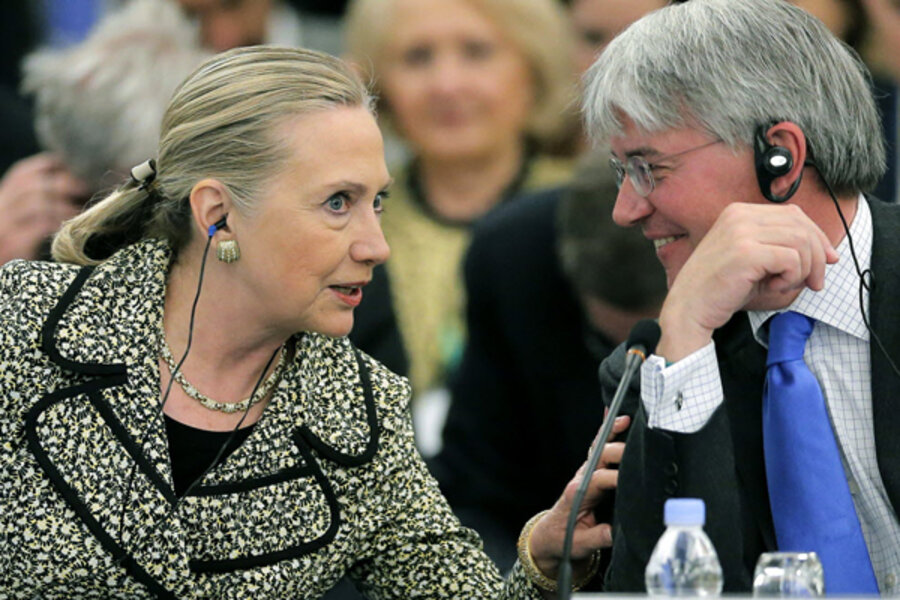Afghanistan funding: Local media already feeling the pinch
Loading...
| Kabul, Afghanistan
International leaders' pledge this weekend to provide $16 billion in aid to Afghanistan over four years comes as a relief to many Afghans who have long worried that the international community would turn its back on them as happened after the Soviet war.
Though a substantial commitment, $4 billion a year in aid represents a drop in the level of assistance Afghanistan has become used to since the US-led invasion in 2001. Already, the United States has scaled back reconstruction spending in the country by 34 percent, causing a number of Afghan organizations to reconsider their strategies and future sustainability.
Among those already affected is the Afghan news industry. News agencies have been forced to make cuts, cancel programming, and reduce coverage as the tide of international funding recedes. The agencies that remain unaffected are predominantly those backed by political groups, often ethnically based, which predictably produce news with an agenda and protect party elites from scrutiny.
After the fall of the Taliban in 2001, independent Afghan media was all but nonexistent. For international donors looking to establish an open political culture, supporting a nascent independent media was a clear choice.
“It’s a reality that after 2001, most of the media outlets were established or started through the funding of foreign countries. Until now, they were just looking after foreign funding and they never thought about standing on their own two feet,” says Professor Mohammad Wahid Gharwal, head of the journalism department at Kabul University. “I’m worried that if the international community decreases or stops funding the Afghan media, there won’t be a vibrant situation for the Afghan media in the future.”
One of the most respected new outlets has been Pajhwok Afghan News, an agency with reporters across the country, many of whom international journalists would tap in dangerous areas.
Pajhwok was started entirely with funding from the United States Agency for International Development in 2004 with a plan to gradually reduce financial support until it was independent. That day came early this year. However, little more than six months after US funding ended, the situation already looks grim. Last month, the news organization laid off 70 of its 186 employees – a 38 percent reduction.
A response to the loss of donor funding, the cuts were also preemptive. Pajhwok's senior editors say they want to prepare for a future post-2014 when they say they expect ad revenues to drop as companies who worked with foreigners look to save money cutting ad budgets. They're also expecting their international subscriber base to shrink as the world inevitably loses interest in Afghanistan without a NATO presence here.
Disappointed about the cuts, Pajhwok’s leadership says they are optimistic they can survive without donor funding.
“If we’re not thinking about it now, it will be very difficult in 2014,” says Danish Karokhel, director and editor in chief of Pajhwok.
Pajhwok is far from the only media outlet affected by reductions in donor spending. Other papers and TV stations have used funding to expand their coverage into different regions of Afghanistan or offer educational programming.
The newspaper 8am Daily recently lost a grant to provide coverage of four northern provinces along with another grant that supported investigative journalism projects. Shah Hussain Murtazawi, the paper’s deputy chief editor, says that the paper used the investigative grant to focus largely on uncovering government corruption, a critical issue in Afghanistan. Without external funding, he says the paper cannot afford such investigations and is now limited to basic news coverage.
“Now we have climbed all the way to the peak and if we fall from here it won’t help. I think the international community should realize this and not let go of the Afghan independent media,” he says.
News outlets are not necessarily collapsing as a result of the funding shortages, but many say they have had to adapt in ways they would rather not to stay afloat. Saba TV has relied on grants to provide educational programming for its viewers; however, in recent months it’s lost much of this funding and has had to cancel several independently produced TV programs.
The loss of the funding does not mean Saba has stopped broadcasting. But to fill the former time slots, which used to educate people about health and governance issues, the station now runs Turkish soap operas dubbed in Dari. Without funding, Abdul Wahid Hamidi, managing director of the Saba Media organization, says his station has been forced to become more responsive to consumer demands, which call mostly for music videos, soap operas, and Indian movies.
“I’m afraid that if funding fully stops, yes, we have 30 stations, but every one of them will only play music and TV dramas,” he says. “The main challenge with Afghanistan and other countries like it, is to differentiate between what people want and what people need. Still, in Afghanistan, people want entertainment, but they need education.”
In this climate, the only media organizations immune to funding problems will be those backed by political parties, say most Afghan media experts. If agenda-based media manages to grow and potentially replace or overshadow ailing independent organizations, this could prove particularly problematic in a country like Afghanistan where many people lack the education required to tell the difference between news and subtle, or even overt propaganda.
“Very few people can differentiate between the independent media and the other sources that belong to political leaders or groups, and these people are only in the cities. Even in Kabul, people cannot think or tell the difference. They just know that this is the government channel and they call all others independent media,” says Shahla Farid, a civil rights professor at Kabul University.







